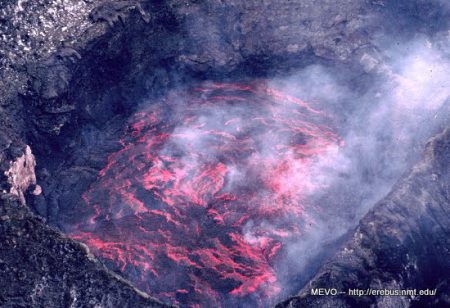Inspired by Erik Klemmetti’s recent blog post about the rise of the term ‘supervolcano’, and by the imminent launch of the Volcano Top Trumps card game, I’ve created a quick game of my own: Soup or Volcano?
The rules are simple: Look at the following five images and decide if they contain soup, or a volcano. Then scroll down to the answers and see how well you did.
Soup or Volcano?
1.
 Image by Dr Nelia Dunbar, http://erebus.nmt.edu
Image by Dr Nelia Dunbar, http://erebus.nmt.edu
2.
3.
4.
 Image: Sir Nico, Wikimedia Commons
Image: Sir Nico, Wikimedia Commons
5.
 Image: Will Hutchison, Oxford University
Image: Will Hutchison, Oxford University
Now scroll down for the answers…
.
…
.
…
.
…a wee bit further…
.
…
.
The Answers
- Volcano. The lava lake of Mount Erebus, Antarctica, is a bubbling cauldron of molten magma. The bubbles burst with a ‘pop’ of low frequency sound (called infrasound). By analysing this, volcanologists can work out the size and pressure of the bubbles and how much gas is released in each.
- Soup. A delicious minestrone. Minestrone soup actually has a lot in common with magma. Both contain a hot liquid (tomatoey-goodness versus molten rock), solid bits (croutons, pasta shapes and vegetables versus crystals) and often gas bubbles (steam versus a mixture of steam, carbon dioxide, sulphur dioxide, chlorine, fluorine and others).
- Volcano. A basalt lava flow a Kilauea, Hawaii. This is erupted a temperatures of over 1000°C. As it cools, the surface develops a skin, a bit like the skin on soup. Molten lava can flow inside the skin, and the whole flow gets thicker from within. There are some great time-lapse videos of this on YouTube.
- Soup. A thick, creamy tomato soup. The measure of the ‘thickness’ or ‘stickiness’ of a liquid is the viscosity and it is measured in units called Pascal-seconds (Pa s). The viscosity of water is about 0.001 Pa s and I would guess that this soup is around 1 Pa s. The viscosity of magma depends on lots of things such as the chemical composition, the temperature, and how much water is dissolved in it. Crystal and water-free basalt has a viscosity of ~10 to ~100 Pa s. Other types of magma can have viscosities of over 1,000,000 Pa s.
- Volcano. The crater of Colima volcano, Mexico, contains a lava dome. The lava here is of andesite or dacite composition is much more viscous than the basalts in Hawaii. The dome is covered in blocks of broken, solidified lava, but the perfectly flat top surface is a clue that there is liquid underneath. New magma oozes into the crater, then spills over the edge and tumbles down the side in spectacular glowing rockfalls.
http://vimeo.com/62885359
How well did you do?
- 5 points: Congratulations! Your powers of separating food from large bits of rock are impressive. Come back next week to try your luck against Level 2: Pasta or Planet? Or maybe not.
- 0 to 4 points: Are you serious? This was not a hard quiz, but your results were terrible. I recommend booking a trip to Kilauea in Hawaii, or Stromboli in Italy to see some real volcanoes in action. Don’t forget to pack a spoon.




Pingback: Sources of reliable information about large Icelandic fissure eruptions | Volcan01010